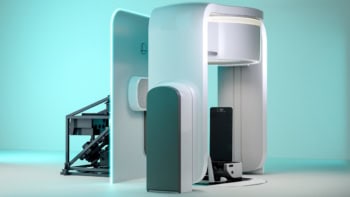
Researchers in the US have developed a new technique to distinguish tumours from healthy tissue in the brain. Based on stimulated Raman-scattering microscopy, the technique could boost the success rate for the complete surgical removal of brain tumours.
Normal cancer surgery on the brain starts with a magnetic-resonance image to plan the operation and to predict the location of the tumour. However, during the surgical procedure it is largely up to the surgeon to determine which tissue is tumorous and which is healthy. Tumorous tissue often feels different and has a different colour. But the differences are slight and for this reason more than 75% of brain-cancer patients are thought to leave theatre with a less-than-optimal amount of their tumour eradicated.
With much room for improvement, medical scientists have spent decades developing more advanced ways of delineating tumours from healthy tissue. One accurate yet expensive option is to have a magnetic-resonance imaging system installed in the theatre so that surgeons can have images of remaining tumour tissue continually updated while they are operating. Another more widely used technique is known as fluorescence-guided surgery and involves the application of a certain acid that breaks down into a fluorescent compound in tumour cells only. Through a microscope this compound can reveal tumorous tissue but it only works for the tumours – so-called high-grade gliomas – that are the least operable.
Vibrational signatures
The latest imaging technique is based on Raman scattering and was developed by chemical biologist Sunney Xie at Harvard University and colleagues, who believe it could prove more successful than either of these existing methods. In normal Raman-scattering microscopy, the presence of a specific molecular species can be detected by firing laser light at a sample and looking for species-specific shifts in the wavelength of some of the scattered light – shifts that correspond to vibrational transitions in the molecule. Potentially this allows a user to uncover several different chemical components of a sample, although the process is time consuming. A slightly different method known as stimulated Raman scattering (SRS) microscopy uses two lasers whose frequency difference is tuned to match specific vibrational signatures. As long as the user knows what they are looking for, this technique can generate much stronger, faster images.
Xie has pioneered the medical development of SRS microscopy in recent years and now his group has turned it to brain-tumour surgery. The technique makes use of the fact that tumours contain large amounts of protein and far less lipids (fatty compounds), while healthy brain tissue is rich in both. The researchers therefore tuned their lasers to the signatures of both lipids and proteins. Then they used the system to illuminate the brains of mice that had grown brain tumours.
Blue and green tissue
The researchers found that their imaging system clearly delineates tumours, which appear blue, from healthy tissue, which appear green. It could even uncover tumorous regions of the mice brains that appeared normal to the naked eye. “At the margin between tumour and normal brain we could see cells – presumably tumour cells – infiltrating into normal brain,” says neurosurgeon group member Daniel Orringer at the University of Michigan in Ann Arbor, US. “This microscopic tumour-brain margin is something that we can only imagine [being able to see] in the operating room today.”
In the long run, I think this will give exquisite images, which will allow you time to look at the structure of the tissue
Nick Stone, University of Exeter
Medical physicist Nick Stone at the University of Exeter in the UK is enthusiastic about the technique: “In the long run, I think this will give exquisite images, which will allow you time to look at the structure of the tissue.” Stone believes that, unlike in-theatre magnetic-resonance systems, SRS microscopy has the potential to be made much more affordable. However, he says that it is an open question whether a non-specialist will be able to interpret – and trust – the images.
Orringer says that the next step will come next year, when he and his colleagues collect SRS images of human brain-tumour specimens. If that is successful, they plan to develop a handheld SRS imaging system. “We anticipate that our initial clinical trial utilizing SRS microscopy in living patients will occur within the next five years,” he says.
The research is described in Science Translational Medicine 5 201ra119.



